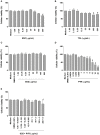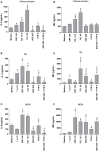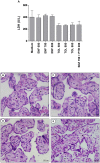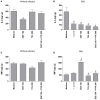Enrofloxacin and Toltrazuril Are Able to Reduce Toxoplasma gondii Growth in Human BeWo Trophoblastic Cells and Villous Explants from Human Third Trimester Pregnancy
- PMID: 28798905
- PMCID: PMC5526852
- DOI: 10.3389/fcimb.2017.00340
Enrofloxacin and Toltrazuril Are Able to Reduce Toxoplasma gondii Growth in Human BeWo Trophoblastic Cells and Villous Explants from Human Third Trimester Pregnancy
Abstract
Classical treatment for congenital toxoplasmosis is based on combination of sulfadiazine and pyrimethamine plus folinic acid. Due to teratogenic effects and bone marrow suppression caused by pyrimethamine, the establishment of new therapeutic strategies is indispensable to minimize the side effects and improve the control of infection. Previous studies demonstrated that enrofloxacin and toltrazuril reduced the incidence of Neospora caninum and Toxoplasma gondii infection. The aim of the present study was to evaluate the efficacy of enrofloxacin and toltrazuril in the control of T. gondii infection in human trophoblast cells (BeWo line) and in human villous explants from the third trimester. BeWo cells and villous were treated with several concentrations of enrofloxacin, toltrazuril, sulfadiazine, pyrimethamine, or combination of sulfadiazine+pyrimethamine, and the cellular or tissue viability was verified. Next, BeWo cells were infected by T. gondii (2F1 clone or the ME49 strain), whereas villous samples were only infected by the 2F1 clone. Then, infected cells and villous were treated with all antibiotics and the T. gondii intracellular proliferation as well as the cytokine production were analyzed. Finally, we evaluated the direct effect of enrofloxacin and toltrazuril in tachyzoites to verify possible changes in parasite structure. Enrofloxacin and toltrazuril did not decrease the viability of cells and villous in lower concentrations. Both drugs were able to significantly reduce the parasite intracellular proliferation in BeWo cells and villous explants when compared to untreated conditions. Regardless of the T. gondii strain, BeWo cells infected and treated with enrofloxacin or toltrazuril induced high levels of IL-6 and MIF. In villous explants, enrofloxacin induced high MIF production. Finally, the drugs increased the number of unviable parasites and triggered damage to tachyzoite structure. Taken together, it can be concluded that enrofloxacin and toltrazuril are able to control T. gondii infection in BeWo cells and villous explants, probably by a direct action on the host cells and parasites, which leads to modifications of cytokine release and tachyzoite structure.
Keywords: Toxoplasma gondii; enrofloxacin; placenta; toltrazuril; treatment; trophoblast.
Figures









Similar articles
-
Leaf hydroalcoholic extract and oleoresin from Copaifera multijuga control Toxoplasma gondii infection in human trophoblast cells and placental explants from third-trimester pregnancy.Front Cell Infect Microbiol. 2023 Feb 13;13:1113896. doi: 10.3389/fcimb.2023.1113896. eCollection 2023. Front Cell Infect Microbiol. 2023. PMID: 36860986 Free PMC article.
-
Susceptibility of human villous (BeWo) and extravillous (HTR-8/SVneo) trophoblast cells to Toxoplasma gondii infection is modulated by intracellular iron availability.Parasitol Res. 2019 May;118(5):1559-1572. doi: 10.1007/s00436-019-06257-2. Epub 2019 Feb 22. Parasitol Res. 2019. PMID: 30796516
-
Copaifera spp. oleoresins impair Toxoplasma gondii infection in both human trophoblastic cells and human placental explants.Sci Rep. 2020 Sep 16;10(1):15158. doi: 10.1038/s41598-020-72230-0. Sci Rep. 2020. PMID: 32938966 Free PMC article.
-
Do the placental barrier, parasite genotype and Toll-like receptor polymorphisms contribute to the course of primary infection with various Toxoplasma gondii genotypes in pregnant women?Eur J Clin Microbiol Infect Dis. 2014 May;33(5):703-9. doi: 10.1007/s10096-013-2017-3. Epub 2013 Nov 30. Eur J Clin Microbiol Infect Dis. 2014. PMID: 24292064 Free PMC article. Review.
-
The Search for Drugs Derived from Natural Products for Toxoplasma gondii Infection Treatment in the Last 20 Years - A Systematic Review.Curr Top Med Chem. 2024;24(22):1960-1999. doi: 10.2174/0115680266299409240606062235. Curr Top Med Chem. 2024. PMID: 38952156
Cited by
-
Leaf hydroalcoholic extract and oleoresin from Copaifera multijuga control Toxoplasma gondii infection in human trophoblast cells and placental explants from third-trimester pregnancy.Front Cell Infect Microbiol. 2023 Feb 13;13:1113896. doi: 10.3389/fcimb.2023.1113896. eCollection 2023. Front Cell Infect Microbiol. 2023. PMID: 36860986 Free PMC article.
-
Prenylated chalcone analog-mediated Inhibition of Toxoplasma gondii growth in human trophoblast cell line and villous explants.Sci Rep. 2025 Jul 2;15(1):23539. doi: 10.1038/s41598-025-08764-y. Sci Rep. 2025. PMID: 40604186 Free PMC article.
-
Unifying Virulence Evaluation in Toxoplasma gondii: A Timely Task.Front Cell Infect Microbiol. 2022 Apr 28;12:868727. doi: 10.3389/fcimb.2022.868727. eCollection 2022. Front Cell Infect Microbiol. 2022. PMID: 35573788 Free PMC article. Review.
-
In Vitro Evaluation of Anti-Parasitic Activities of Quinolone-Coumarin Hybrids Derived from Fluoroquinolones and Novobiocin Against Toxoplasma gondii.Acta Parasitol. 2024 Jun;69(2):1275-1283. doi: 10.1007/s11686-024-00852-9. Epub 2024 May 16. Acta Parasitol. 2024. PMID: 38753101
-
Cyclooxygenase (COX)-2 modulates Toxoplasma gondii infection, immune response and lipid droplets formation in human trophoblast cells and villous explants.Sci Rep. 2021 Jun 16;11(1):12709. doi: 10.1038/s41598-021-92120-3. Sci Rep. 2021. PMID: 34135407 Free PMC article.
References
-
- Angeloni M. B., Guirelli P. M., Franco P. S., Barbosa B. F., Gomes A. O., Castro A. S., et al. . (2013). Differential apoptosis in BeWo cells after infection with highly (RH) or moderately (ME49) virulent strains of Toxoplasma gondii is related to the cytokine profile secreted, the death receptor Fas expression and phosphorylated ERK1/2 expression. Placenta 34, 973–982. 10.1016/j.placenta.2013.09.005 - DOI - PubMed
-
- Barbosa B. F., Lopes-Maria J. B., Gomes A. O., Angeloni M. B., Castro A. S., Franco P. S., et al. . (2015). IL10, TGF beta1, and IFN gamma modulate intracellular signaling pathways and cytokine production to control Toxoplasma gondii infection in BeWo trophoblast cells. Biol. Reprod. 92, 1–13. 10.1095/biolreprod.114.124115 - DOI - PubMed
MeSH terms
Substances
LinkOut - more resources
Full Text Sources
Other Literature Sources
Miscellaneous

